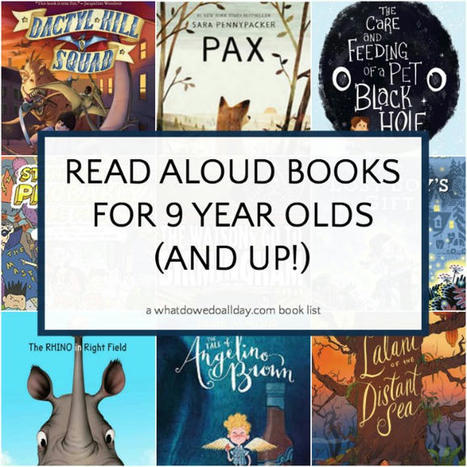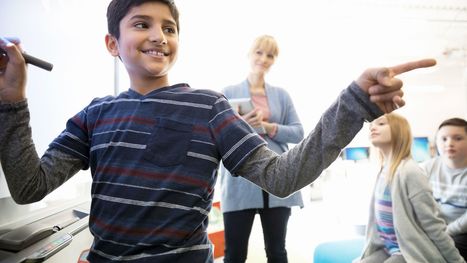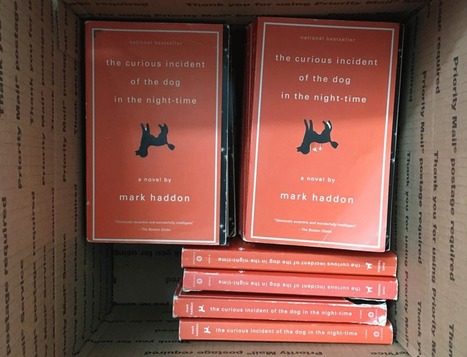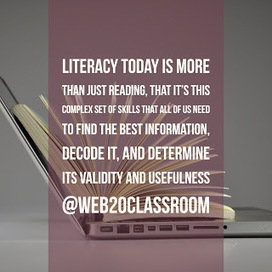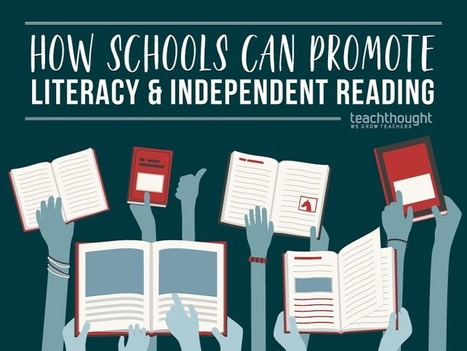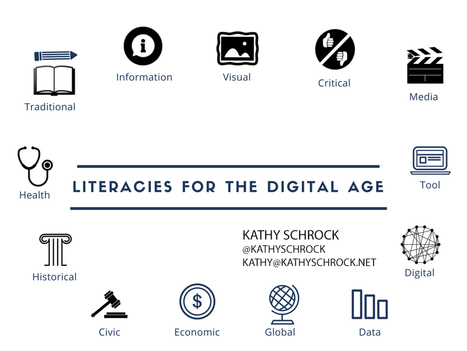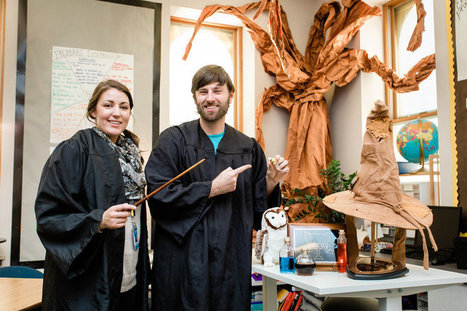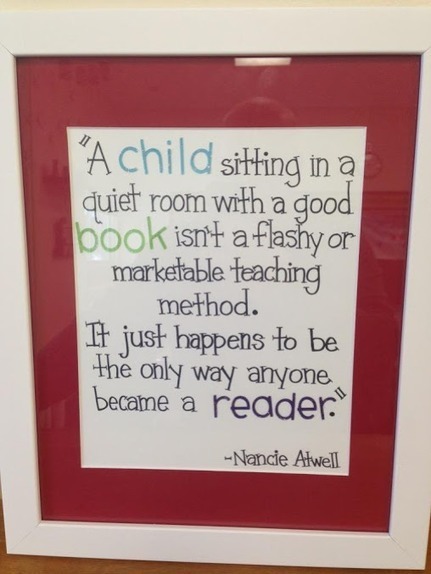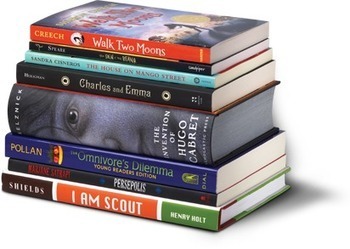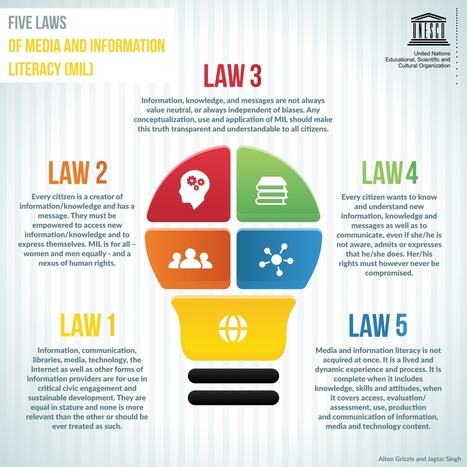 Your new post is loading...
 Your new post is loading...

|
Scooped by
John Evans
|
Fantastic books to read aloud to 9 year olds that engage them with important issues and themes. The best read aloud books to start a meaningful conversation

|
Scooped by
John Evans
|
We have been teaching students how to become better readers and writers for years. With mentor texts, we teach our students about the different genres, text structures, and features that exist within books. Students learn how to identify characters and plots, retell events, or set up a table of contents to reflect the main idea and details of a new writing piece.
The good news is, we can use these same instructional choices during our math instruction. Just as books have a variety of text structures (narrative, informational, biographical) and features (characters, events, language, labels) so too, do math word problems. When we show students how to identify these structures and features within math problems, we increase their ability to comprehend them, solve them, and eventually become the authors of their own math stories. Research shows that readers who can identify the structure of a text are better able to locate the information they need for successful comprehension (Williams, J.P., 2003). This is exactly the result we are looking for when students are solving word problems. We want students to identify the text structure of a math problem, recognize which part is missing, and use questions and known relationships to solve for the missing value.

|
Scooped by
John Evans
|
As I am coaching teachers in learning how to learn and teach FOR the 22nd century, I realize that the gap between being able to read traditional forms of information, communications materials in geneal and reading on new platforms, in new genres and in general new digital forms is widening drastically.
Not too long ago, I wrote a post titled, Our Notion of Literacy and Iliteracy Calls for an Update.
I define literacy as the ability to read and write and being able to express and communicate our ideas to others.
So, in our world, which is BOTH analog AND digital, we need to be literate in both. Especially if we are educators, in charge of teaching our students to be literate for THEIR future. The digital world is not going away, nor can it be ignored in terms of being and staying (critically) informed, lifelong learning, communicating, connecting, collaborating and contributing.
One realisation for me was that new forms of reading and writing did not ONLY have to do with the skillset of learning the logistics of how to read and write on digital platforms, but had EVERYTHING to do with a new mindset that allows for new forms of reading and writing versus merely substituting the way we have done it in analog form before.

|
Scooped by
John Evans
|
or an elementary school teacher who works with economically disadvantaged students, it can be discouraging to hear phrases like “significant achievement gap” or “30-million-word gap” in discussions of the reading and vocabulary development of our students. But research does bear those phrases out: There are clear trends of underachievement in academics for students of low socioeconomic status (SES).
I’ve taught in a Title I school in Northern Virginia for six years, with experience in fourth through sixth grades, and year after year, I work with students who are reading drastically below grade level. There are many things that affect my students that I can’t control, but research has shown that strong, intentional, and explicit instruction can positively impact the reading trajectories of all students, especially those with economic disadvantages.

|
Scooped by
John Evans
|
Educators and researchers are looking to update one of the oldest, most popular—and at times one of the most controversial—methods of targeting instruction: the elementary reading circle.
Grouping students of similar reading skills—think "bluebirds" or "redbirds," for example—has become ubiquitous in American classrooms as a way to target instruction to students' learning needs, spreading from 68 percent of classrooms in 1992 to more than 90 percent by 2015. But evidence suggests that the practice may be less beneficial than teachers think: It can exacerbate achievement gaps and even slow reading growth for some children unless the groups are fluid and focused on skills rather than overall achievement.
When we talk about social skills and social and emotional learning (SEL), an important element is understanding the nuances of language, as well as the context, the situation, we are in with others. Communication in the English language is not simple, even for native speakers.
So when it comes to deciphering tough language, asking groups of students to work together to analyze puns can be both challenging and an enjoyable way to build language and literacy skills.
Every January, Nashville teacher Joel Bezaire reads The Curious Incident of the Dog in the Night-Time aloud to his students. Sounds pretty standard, right? It would be — for an English class. But Bezaire teaches math. The novel is part of a unit on number sense.
While it’s easy to envision using math picture books in elementary school classrooms, literature for older grades poses a bigger challenge. Can reading fit into the curriculum as the books get longer and the math gets more complex?
Bezaire thinks it can, and so does another teacher, Sam Shah, of Brooklyn. The two occupy opposite ends of the secondary math spectrum — seventh-grade pre-algebra and 12th-grade calculus, respectively — and both have found ways to strengthen student engagement through reading.

|
Scooped by
John Evans
|
What is your most memorable math lesson? For me, it was when Mrs. Kaylor helped us visualize and understand place value by building straw men as we counted straws by units of one, ten, and a hundred.
I struggle to come up with many more memories and there's a good chance I'm not alone. If I asked the same question for other subjects, like social studies or language arts, however, I bet your answers would come a lot more easily.
The difference? These subjects include lessons that are often applicable to real life. Whether it's a mock trial, a school play, or a science experiment, project work deepens student learning by allowing them to explore the connections between content and real life.
Math lessons, on the other hand, have historically focused less on real-life connections. Like many students, I excelled in math by memorizing rules and tricks. In college, I trained to teach social studies, but became a math teacher by accident because I had earned enough math credits to qualify for a math teaching certification. It wasn't until I returned to earn a master's in math education that I discovered that math can be so much more than memorization.

|
Scooped by
John Evans
|
"The number one concern that I hear from educators is lack of time, particularly lack of instructional time with students. It's not surprising that we feel a press for time. Our expectations for students have increased dramatically, but our actual class time with students has not. Although we can't entirely solve the time problem, we can mitigate it by carefully analyzing our use of class time, looking for what Beth Brinkerhoff and Alysia Roehrig (2014) call "time wasters." "

|
Scooped by
John Evans
|
What’s the point of Instagram and why should you spend your precious time and money on it? Well, don’t worry about the cost, because it’s FREE! So, all you really need is creativity and a few
minutes a day to make meaningful, fun, and lasting connections with your community. And with Instagram you get a twofer! Even maybe a threefer, fourfer?! (is that a thing?) That’s right, for the amazing low price of FREE, each Instagram post can cross pollinate to your Twitter, Facebook (:-P), Flickr, Tumblr, and that thing called Swarm that kinda took the place of the annoying Foursquare? That’s pretty powerful!
"If the most recent U.S. Election has taught us anything it's that we live in an era of fake news and sites. With accusations flying of manipulation of stories, the media and voters, it’s truly hard to know if what we read on blogs, social media and other sites is actually the truth or a tale spun to generate clicks. To further compound the problem a recent study from Stanford shows that the vast majority of students can’t determine it what they read on websites is true or baloney.
The study showed More than two out of three middle-schoolers couldn’t see any valid reason to mistrust a post written by a bank executive arguing that young adults need more financial-planning help. And nearly four in 10 high-school students believed, based on the headline, that a photo of deformed daisies on a photo-sharing site provided strong evidence of toxic conditions near the Fukushima Daiichi nuclear plant in Japan, even though no source or location was given for the photo.
With many schools and districts rolling out 1:1 initiatives and a push to digitize learning, helping students understand where their information comes from, and if it is reliable and accurate are critical skills, not just for learning for but life as well. "
Via Tom D'Amico (@TDOttawa)
|

|
Scooped by
John Evans
|
In the age of the Common Core and its emphasis upon having students take on more challenging text, independent reading and student choice can easily take a back seat to the demands of increased rigor. However, in a balanced literacy program, they remain important.
Motivation and choice play key roles in reading.
And, strong and capable readers are those who read widely and diversely in a wide variety of genres and text types.
In the quest to build capable readers, promoting independent, self-selected reading remains key. Creating ravenous, lifelong readers doesn’t just happen, it takes a schoolwide culture to help reach that goal.
I have identified thirteen literacies that our students need to become well-rounded 21st-century citizens. These literacies are not taught as separate literacies but are taught across th
Via Tom D'Amico (@TDOttawa)

|
Scooped by
John Evans
|
Whether you're a Gryffindor, a Hufflepuff, a Ravenclaw, a Slytherin or a muggle still hoping your Hogwarts letter will arrive by owl, it is undeniable that the Harry Potter fandom has had a lasting impact throughout the world.
September marked the 20th anniversary of Harry Potter and the Sorcerer's Stone's U.S. release. NPR asked teachers then to tell us how the book has changed the way they teach. We learned that a lot has changed since 1998. Quidditch is no longer just game of fantasy. Fantastic Beasts and Where to Find Them is more than a textbook to pick up in Diagon Alley. And Hogwarts is no longer a place you can only dream of visiting.

|
Scooped by
John Evans
|
Attention exhausted parents: The next time your toddler starts making strange noises or babbling about Paw Patrol, try to strike up a conversation — it could make a big difference later, researchers say.
A study published this week in Pediatrics found that toddlers with parents who spend lots of time listening and chatting with them are more likely to have better language skills and higher IQs a decade later than youngsters left hanging in silence.
"If you knew that children who were fed a certain nutritional diet at age two were not only far healthier as toddlers, but much more likely to be in a healthy weight range at age 12, you'd want to pursue those findings, wouldn't you?" said study author Jill Gilkerson, senior director of research and evaluation at the LENA Foundation, a non-profit charity in Boulder, Col.
"Conversational turns are that diet, that nutrition, for the brain."

|
Scooped by
John Evans
|
I had just finished sharing the latest research about classroom libraries with my teachers at a staff meeting. The research didn’t surprise anyone. Students who are able to utilize a well-stocked, diverse classroom library spend 60% more time reading compared to those that don’t. These same students are also more likely to talk about the books they are reading and make recommendations to other students. Classroom libraries are essential in order to provide students with access to books and motivation to read. There is a direct link between classroom libraries and reading motivation, reading achievement, and reading engagement.

|
Scooped by
John Evans
|
Every January, Nashville teacher Joel Bezaire reads The Curious Incident of the Dog in the Night-Time aloud to his students. Sounds pretty standard, right? It would be — for an English class. But Bezaire teaches math. The novel is part of a unit on number sense.
While it’s easy to envision using math picture books in elementary school classrooms, literature for older grades poses a bigger challenge. Can reading fit into the curriculum as the books get longer and the math gets more complex?
Bezaire thinks it can, and so does another teacher, Sam Shah, of Brooklyn. The two occupy opposite ends of the secondary math spectrum — seventh-grade pre-algebra and 12th-grade calculus, respectively — and both have found ways to strengthen student engagement through reading.

|
Scooped by
John Evans
|
The benefits of even high-quality preschool programs tend to fade over time, but extracurricular programs in early grades may help boost the good effects of early education after students start school, according to a new longitudinal study by the research firm MDRC.
Low-income students who participated in both a math-focused preschool curriculum and extracurricular math clubs during their first year of school closed nearly 30 percent of the math achievement gap between themselves and their wealthier peers by the end of kindergarten, the study showed.

|
Scooped by
John Evans
|
As an elementary principal the last seven years, the schools I have had the honor to lead have hosted site visits. Other schools have come to observe the inner workings of our organization. These visits usually revolve around our literacy initiatives. We share how our continuous focus on reading, writing, speaking, and listening has resulted in increased achievement and engagement for our students. This isn’t something we brag about; it is how we have done business.
Out of the 15 or so schools that have come to visit, can you guess how many have walked away and started their building-wide focus on literacy? To my knowledge: zero.

|
Scooped by
John Evans
|
I have identified thirteen literacies I feel our students need to succeed. (See Kathy’s Katch blog posts from from September 2014 to June 2015 to learn more about them.) One of the skillsets is the “traditional literacy skills” of reading and writing. Because March is NEA’s “National Read Across America Month“, I thought I would concentrate on identifying resources for the traditional literacy skills of reading and writing.
This week UNESCO launched a framework illustrating its Five Laws of Media and Information Literacy (MIL).
This global strategy marries the large, but often separated, disciplines of information literacy and media literacy and creates a common vocabulary for folks in multiple areas of knowledge to engage in conversation. It also positions these critical literacies as a combined set of competencies–knowledge, skills and attitudes–central for living and working in our world today.
Modern graphic novels have emerged as effective teaching tools that help improve literacy, explain complex concepts, and get students excited about reading.
Via Ana Cristina Pratas
|
 Your new post is loading...
Your new post is loading...
 Your new post is loading...
Your new post is loading...











